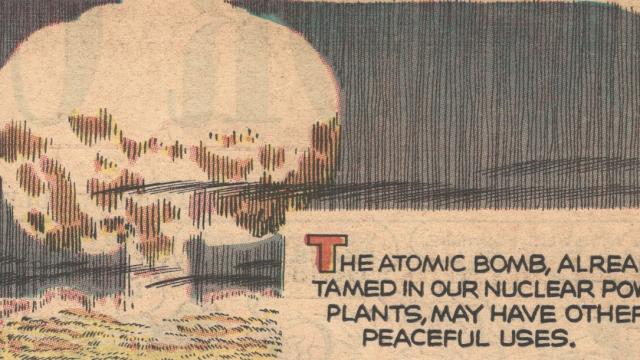Nuclear weapons can wipe out an entire city in the blink of an eye, but what about all the good they can do? That was the pitch from this 1965 comic strip that extolled the virtues of nuclear bombs to build everything from highways to a “second Panama canal.”
Americans of the 1950s and ‘60s had a complicated relationship with nuclear weapons. People were constantly being bombarded with the idea that nukes were necessary to deter the Soviet Union from invading the United States, but there was a very real fear that the same type of weapons dropped on Hiroshima and Nagasaki could be used on American cities like New York.
U.S.President Dwight Eisenhower delivered his famous “Atoms for Peace” speech to the United Nations on December 8, 1953, and the U.S. government devised a plan to normalise the United States’ new nuclear capabilities by presenting them as tools that had many more uses beyond creating death and destruction. Non-government media were happy to relay that message, as we can see from this comic strip.
This particular pro-nuke comic was written by scientist and educator Athelstan Spilhaus and was published in the July 4, 1965 edition of newspapers around the country as part of the long-running Our New Age series.
Titled, “Atomic Ditch Digging,” this edition of the strip explained that humanity had harnessed the atom, and now it would be used for countless useful purposes in peacetime. Peacetime is a relative word, of course, since the U.S. was dramatically escalating its presence in Vietnam during the summer of 1965 and expanding the military draft at home.
Nevertheless, the comic explained that nuclear explosions were far cheaper than traditional explosives and could be used for building roads, railways, and “huge canals.” The illustration, done by Gene Fawcette, even included a shovel with a nuclear symbol, further pressing the idea that this was a perfect use of atomic energy for large infrastructure projects.
“For an explosion equivalent to 2 million tons of TNT, chemical explosives would cost $US2 ($3) million, nuclear just $US600,000 ($855,804)!” the strip exclaimed.
The strip went on to explain that by placing a small nuclear device, just 1.22m in diameter, inside Earth, the explosion would be entirely safe. Or, that was what they claimed anyway.
“Most of the radioactivity could be kept underground so that workers could go into the craters within a week or two and people live nearby within a year,” the comic strip said.
The last panel of the strip explained that a “second Panama Canal” could be dug for “a tenth of the cost of doing it mechanically.” If only President Teddy Roosevelt had been able to use nuclear bombs in the first decade of the 20th century, right? Then those 5000 or so people who died building the first Panama Canal would’ve been fine. On second thought, Teddy probably would’ve been a terror with nukes, on account of all the imperialism. Scratch that idea.
This wasn’t the first time that Americans of midcentury heard about the fantastic ways that new innovations would help build critical infrastructure. ABC’s Disneyland TV show aired an episode on May 14, 1958, titled, “Magic Highway USA,” that detailed all the futuristic ways roads would be built in the world of tomorrow.
This comic strip was just one example of how nuclear devices were normalized in the 1950s and ‘60s, but the following decade would see major pushback from the American public against the idea that nukes were safe.
The 1970s included plenty of protests against nuclear-powered everything, especially after the 1979 movie The China Syndrome starring Jane Fonda and Michael Douglas, a disaster film about a coverup at a nuclear power plant. Incredibly, the movie was released in the U.S. on March 16, 1979, and the Three Mile Island nuclear accident happened just a couple of weeks later, on March 28.
Los Alamos National Laboratory examined the possibility of creating tunnels with nukes in the 1970s, but the U.S. never did create new infrastructure using the controversial weapons technology beyond some tests.
By the 1980s, nuclear power and other peaceful uses of the technology had fallen out of favour with the American public (it’s no accident that Homer Simpson works in a nuclear plant) and the idea that we could build roads by blowing up mountains with nukes became laughable.
But who knows what the future holds? We do live in a ridiculous era filled with the most incompetent U.S. federal government that the world has ever seen. The president even believes that wind turbines cause cancer, so anything is possible when we think about the next decade of critical infrastructure construction.
Would you really be surprised if Trump said that he wanted to build new highways using nuclear weapons? I sure as hell wouldn’t.
